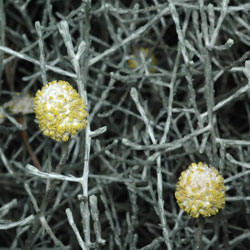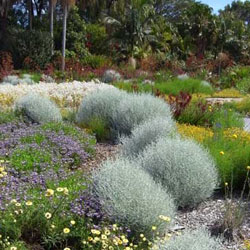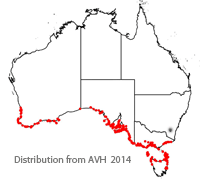Leucophyta brownii
 |
 |
Cushion Bush
Leucophyta brownii Cass.
 Leucophyta brownii, commonly known as the Cushion Bush, is a perennial, evergreen, coastal shrub in the flowering plant family Asteraceae. It is naturally distributed along the south coast of Australia’s mainland, the northern coasts of Tasmania, King Island, and Flinders Island.
Leucophyta brownii, commonly known as the Cushion Bush, is a perennial, evergreen, coastal shrub in the flowering plant family Asteraceae. It is naturally distributed along the south coast of Australia’s mainland, the northern coasts of Tasmania, King Island, and Flinders Island.
Leucophyta brownii is a dwarf shrub that grows up to 1 metre in height, and has a very compact, rounded habit. The plant is silver with scale-like leaves that lie against stems lined with woolly hairs. Mature individuals are brown and woody in the centre. Yellow button-like heads flower from late spring to summer and are pollinated by various insects. Heads appear silver when budding, and fruiting heads appear grey-brown.
Leucophyta brownii naturally occurs amongst coastal dunes and cliffs. It is extremely tolerant to salt spray, wind, drought, and frost. It grows most successfully in full sun, but may tolerate partial shade. Well-drained sandy soil is ideal, but it can also grow in finer soil. It grows poorly in high humidity however, and will die easily if waterlogged, meaning it cannot grow in more tropical regions.
These characteristics make Leucophyta brownii ideal for cultivation in semi-arid or temperate coastal gardens. The plants reflect light very strongly, providing great contrast against other vegetation due to their silver colour. Consequently they are often used to define walking paths in coastal areas, because they are easily seen at night. L. brownii’s habit is also effective for growing a low hedge. They will thrive in nutrient-poor soil and do not need fertiliser. Unless pruning is required to maintain a desired plant shape, L. brownii is very low-maintenance.
Successful propagation is very easy to achieve. Plants can be propagated via seed, which will germinate 10-30 days after sowing, where no pre-sowing treatment is required. However, they are usually propagated via cuttings, which should be taken from semi-hardened branches. They prefer alkaline soils, and should not be overwatered, as this will often cause death. Plants may not be highly tolerant to drought and other stresses until they are established and mature, so young plants may need light watering or a small nutrient supplement if necessary (via a slow-release native plant fertiliser).
Text by Carolyn A. Vlasveld (2014 Student Botanical Intern).
Name meaning: Leucophyta browniiLeucophyta – derived from the Greek terms leuco (meaning grey-white), and phyto (meaning plant). brownii – named after the 18th–19th century botanist Robert Brown. |
References:
Elliot, W.R. and Jones, D.L. (1993) Encyclopaedia of Australian Plants Suitable for Cultivation, Volume 6. Lothian Publishing Pty Ltd.
Hampshire, R.U. (2014) ANBG Horticulturalist, pers. comm.
Rodd, A.N., Rodd, T., and Cundall, P. (2005) ABC Gardening Australia: Flora’s Trees and Shrubs. Global Book Publishing Pty Ltd.
Spencer, R. (2002) Horticultural Flora of South-Eastern Australia, Volume 4: Flowering Plants, Dicotyledons. University of N.S.W. Press, Sydney.
![An Australian Government Initiative [logo]](/images/austgovt_brown_90px.gif)

